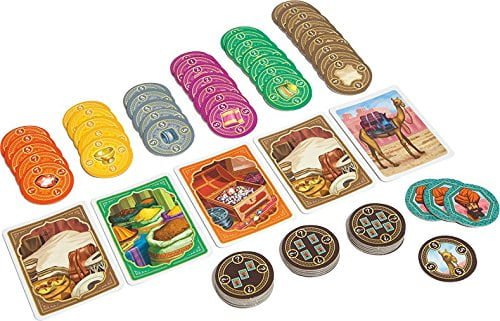Jaipur is a two player game where you are competing to be the Maharajah’s personal trader by winning two rounds, which you do by having the most points at the end of a round.

You put three camels in the middle with two random cards from the top of the deck next to them to make a 5 card ‘marketplace’. Each player then gets 5 cards which you look at and place any camels face up in front of you, keeping the rest secret. All the other cards go in a draw pile. There are 6 stacks of points tokens that correspond to the 6 goods you can sell, as well as random bonus tokens as well.
On your turn you can choose to take all the camels from market and put them in front of you, a single good for free to your hand or multiple goods replacing them with cards from your hand. There must always be 5 cards in the marketplace so if you take the camels or a single good you must put a new card there from the draw pile.

You’re only allowed 7 cards in your hand at any one time, but on your turn you can choose to sell cards as well. You discard the cards you want to sell, take the amount of tokens you sold off the points stack that matches them. If you sell 3 or more of the same card at once you also gain a bonus token. The bonuses give extra points. Importantly you can only trade one good on your turn and the precious metals need to be a pair to be traded in.
The round ends when you have used up three stacks of tokens or there’s no cards left to go into the marketplace.
It sounds slightly complicated but plays really quickly and easily.

Picture courtesy of Freepik.com
Questions to explore character:
- Did you sell as soon as you could or did you wait to build a collection first?
- Do you find it easy to know when to spend money and when not to?
- Do you think it’s this easy to sell things in markets nowadays?
- What goods would you want to sell if you could?
- Do you think traders sell things they want for themselves or do they pick what’s best for the market?

Image courtesy of publicdomainpictures
Links to Scripture
Markets are often the central hub of civilisation. You probably go into town to meet with your friends, possibly to the mall to look around the shops, eat food and spend time together. The same has always been true and markets tend to be places where conversations are had and prophets speak in the Bible.
However there are some places that are not suitable to be markets. And the Temple of Jerusalem, a place that was meant to be the House of God is definitely one of those. However, those in charge at the time of Jesus had allowed people to come and sell animals for sacrifice and lend money. The sales of which all put money into the Temple priest’s hands, and was a sign of the corrupt leadership. This is one of only 3 times we see Jesus angry.
It was almost time for the Jewish Passover Feast. So Jesus went up to Jerusalem.In the temple courtyard he found people selling cattle, sheep and doves. Others were sitting at tables exchanging money.So Jesus made a whip out of ropes. He chased all the sheep and cattle from the temple courtyard. He scattered the coins of the people exchanging money. And he turned over their tables.He told those who were selling doves, “Get these out of here! Stop turning my Father’s house into a market!”His disciples remembered what had been written. It says, “My great love for your house will destroy me.” ( Psalm 69:9 )
– John 2:13-17 NIRV
He drove them out of the Temple, refusing to let people profit off other’s faith in His Father. At the end of the passage it says something interesting – My great love for your house will destroy me. What do you think the priests felt at Jesus destroying something that was making them money, embarrassing them in the process? What did they end up doing to Jesus in the end? Do you think it may be linked?
Links to buy
Reminder, all Amazon links from this point on (including pictures) are Amazon Affiliate links and will provide me with a slight commission. For more information check the Disclosure page.
Game images taken from the Amazon page linked above.

